

The 14th Exhibition: 2022.7.30 - 2024.1.3
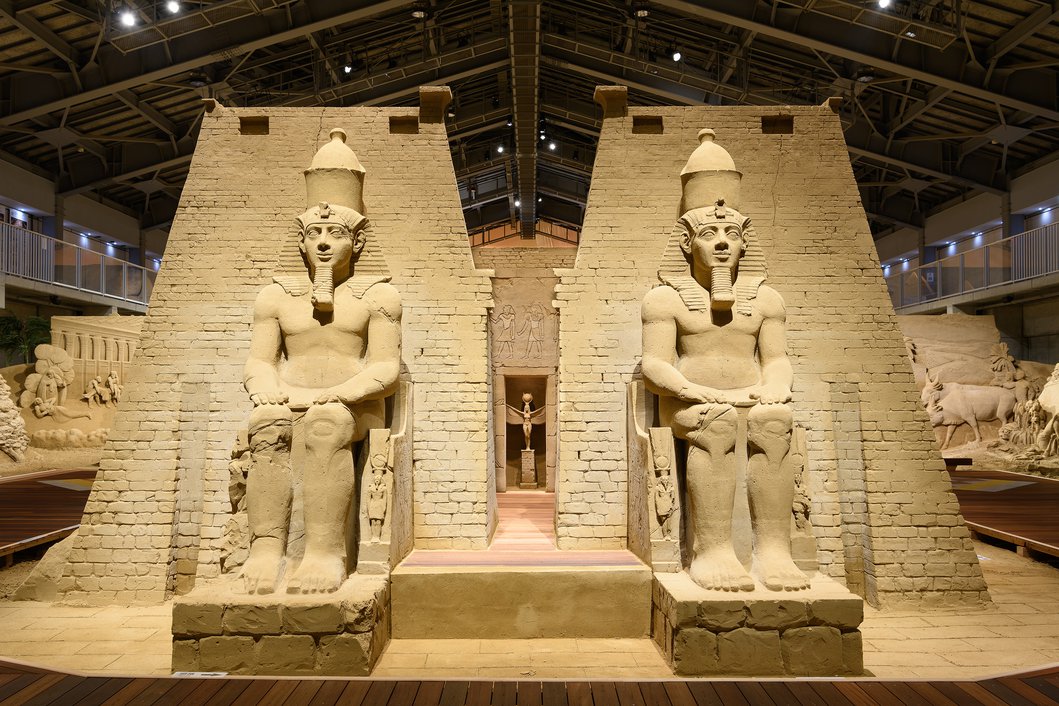
Luxor Temple
Ancient Egyptian pharaohs built many temples as places to worship the gods. The Luxor Temple and the Temple of Isis at Philae are among the most well-known. The Luxor temple was first built around the end of the 14th century BCE by Amenhotep III but continued to undergo additional constructions by subsequent pharaohs, including Ramesses II’s major expansion. Architectural features include giant statues of Ramesses that flank the gateway of the temple’s pylon and the colonnade that leads to the inner sanctum lined with statues of Osiris and papyrus columns. The Temple of Isis, built in the 4th century BCE during the Ptolemaic dynasty, is dedicated to Isis, the goddess of domestic life and fertility. A widely worshipped deity, the popularity of Isis worship even reached the Roman Empire at one point. As a result, even Roman emperors contributed to the expansion of this temple. This work combines elements from both temples to illustrate the sanctity of these places of ritual.
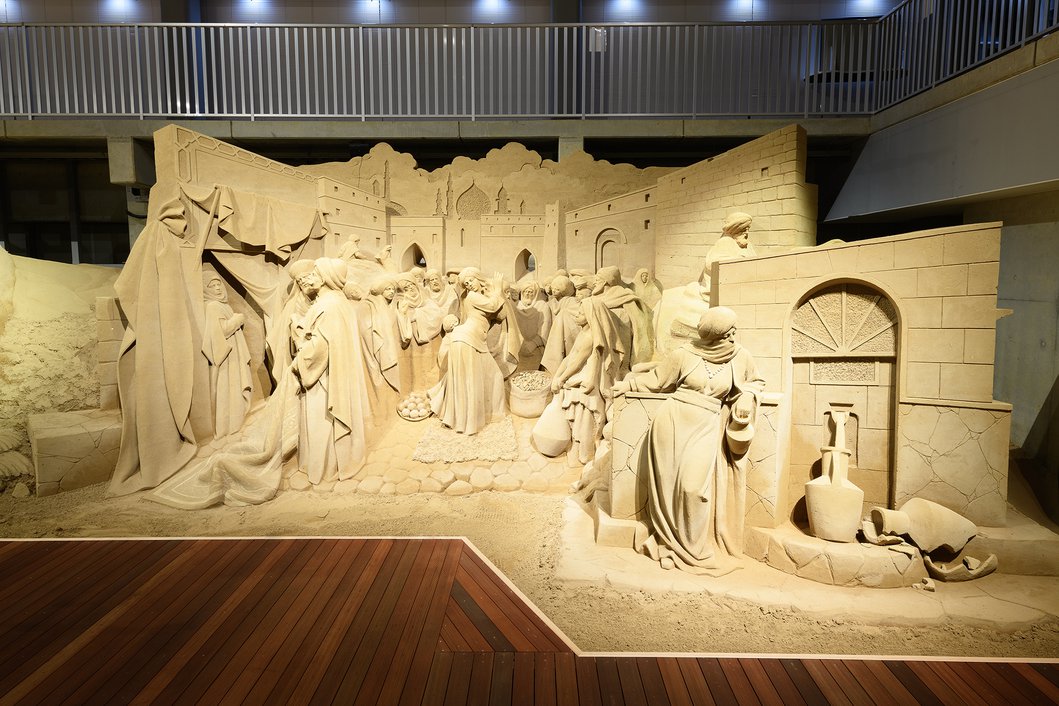
Bazaar in Cairo
A bazaar, or "souk" in Arabic, is bustling with people. Cairo became a trade hub as maritime trading between the Mediterranean Sea and the Indian Ocean flourished from the latter half of the 10th century CE. As a result, many bazaars sprung up all over Cairo, including the famous bazaar Khan el-Khalili. Though initially set up as lodging for Islamic traders, it grew into a bazaar as more and more people and shops began to gather around it. Traders at the time were said to have been extremely wealthy as they even did business with the royal family. The street leading to a mosque is incredibly lively as shoppers check out fruits and carpets while a crowd gathers around a dancer to watch her perform.
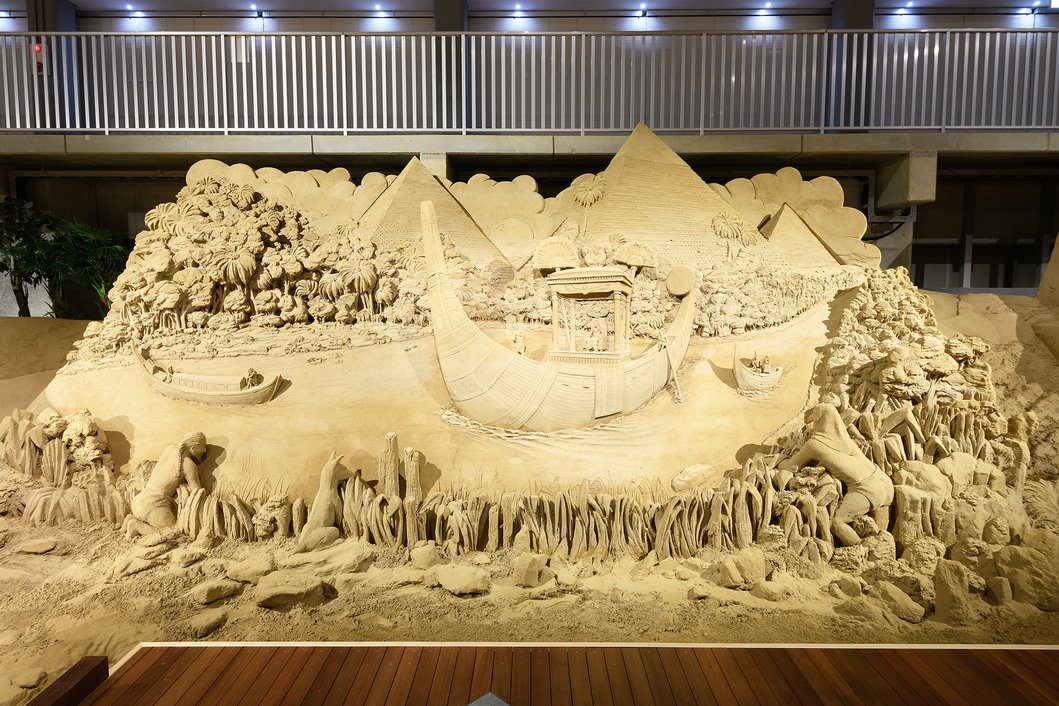
Nile River
The Nile River, considered the longest river in the world, has been at the center of people's lives since ancient times. Once-a-year deluge nurtured rich soil that allowed farming in an otherwise barren desert region. People also used mud from the river bed to make sun-dried bricks and pottery. At the same time, it served as a vital transportation route that stretched north to south. Everything from pharaohs' boats to transportation boats carrying things like grains and building stones used the river. Cities, temples, and monuments were built all along the river, and it was here that the Egyptian civilization reached its height of prosperity. To highlight the Nile's value, ancient Greek historian Herodotus once called Egypt "the gift of the Nile." Even today, it remains an important water source and an indispensable part of people's lives.
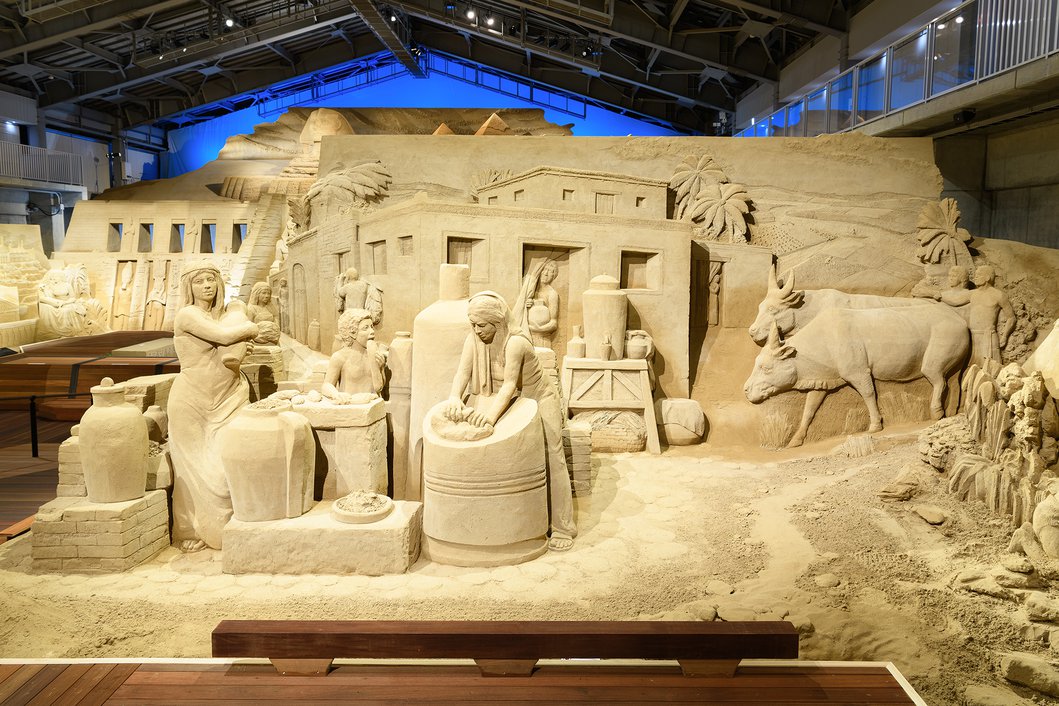
Life in Ancient Egypt
Ancient Egyptian life revolved around agriculture. Many of them were farmers who grew wheat, barley, and vegetables such as onions and lettuce. The bread was their staple food. Each household would make its bread by milling wheat into flour and baking them in an oven with ceramic molds. By the New Kingdom period, even professional bakers had appeared - remnants of bakeries were found at various ruins. While people often ate fish, meat was considered a luxury food. An average person would rarely eat meat since cows were kept as beasts of burden or for their milk. Various crops were grown throughout the year except during the flooding of the Nile. While the river flooded, farming stopped, and people went to work on pyramid constructions or river-improvement projects. They would go back to farming after the water had subsided. People observed the stars to predict when each season of this yearly cycle would begin – this practice later became one of the bases for the solar calendar.
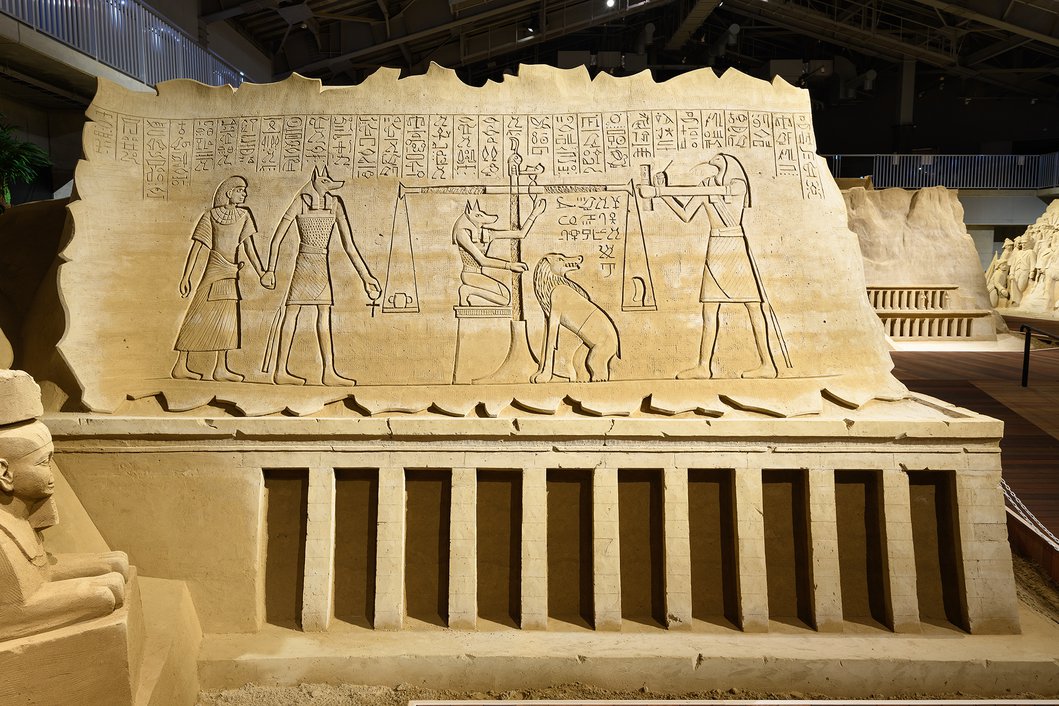
Ancient Egyptian Religion - Book of the Dead
Ancient Egyptians believed in the afterlife. During the New Kingdom period (after the 16th century BCE), scrolls called the "Book of the Dead" were placed in coffins to pray for a good voyage into the afterlife. These papyrus scrolls were written in ancient hieroglyph and contained spells and instructions to help the deceased overcome obstacles in reaching paradise. Out of around 190 chapters, "the Judgement of the Dead" is the most famous - god Anubis would weigh the deceased's heart on a pair of scales against ostrich feathers to judge whether they had committed any sins in their lifetime. If a scale tipped, a beast would devour the heart, and their soul lost forever. If the scales balanced themselves, god Horus would take them to meet god Osiris, the ruler of the afterlife. In his paradise, the deceased would be reborn into an eternal life of happiness.
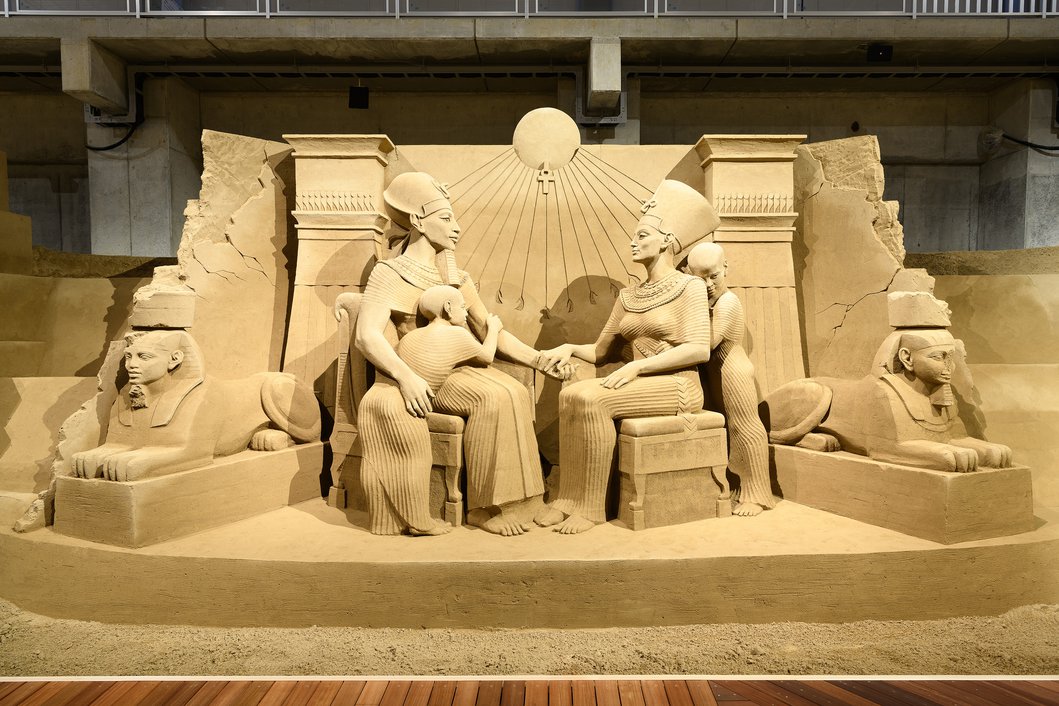
Akhenaten and his Royal Family
Amenhotep IV, who later became Akhenaten, was a pharaoh from the Eighteenth Dynasty. He is notable for attempting a religious reform by introducing Atenism, monotheistic worship of the sun god Aten. He was driven, in part, by his unease over the growing influence of priests in the capital city of Thebes. He also abandoned his old name to become Akhenaten and created a new capital called Amarna. Unfortunately, his reforms were not very well-received. He was labeled a heretic after his death; as a result, his successors erased his name from monuments and destroyed his constructions. Unpopularity aside, Akhenaten's reform also had a cultural influence as a new art style emerged called the Amarna art. This innovative art style emphasized a more realistic depiction. Other distinctions included god Aten's portrayal as the sun with the sun ray and a change in how the pharaohs were presented - the focus on more honest depictions like that of a family scene, as opposed to the emphasis on grandiose and idealized forms of the past. Akhenaten had six daughters with Queen Nefertiti and eight children when including other concubines. It is believed that one of his children was Tutankhamun.
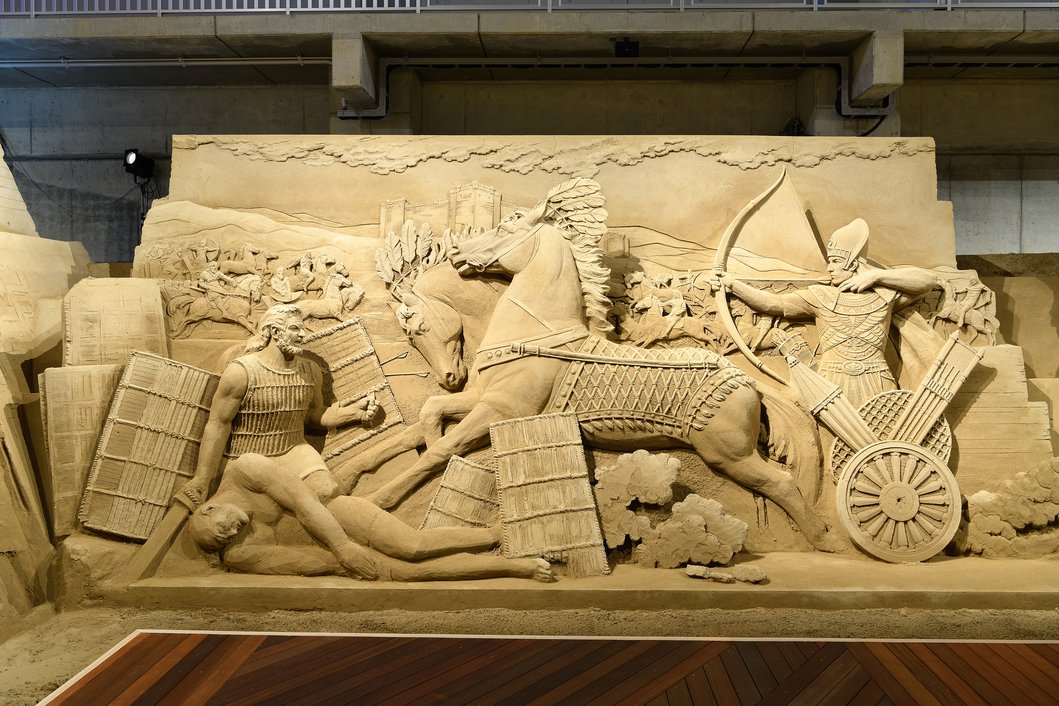
Battle of Kadesh
Fought around 1274 BCE, the Battle of Kadesh was a battle of territorial conflict between Egypt and the Hittite Empire. Deceived by a spy's false information, Pharaoh Ramesses II and his army came under attack by the Hittite army in Kadesh (present-day Syria). Ramesses was said to have been over 180 cm tall, unusually tall for people at the time, and he used a powerful bow that only he could wield to fight heroically. Nevertheless, the Hittite army was equally formidable, so the battle eventually reached a stalemate. According to a legend, the Hittite King Muwatalli II offered a ceasefire after witnessing Ramesses' bravery on the battlefield, to which the Egyptians agreed. Later, a peace treaty was signed, believed to be the first of its kind in recorded history, and they enjoyed an amicable relationship. Although the Egyptian side is likely to have suffered more casualties, reliefs on the walls of Ramesses II's structures praise this battle as one of his great victories.
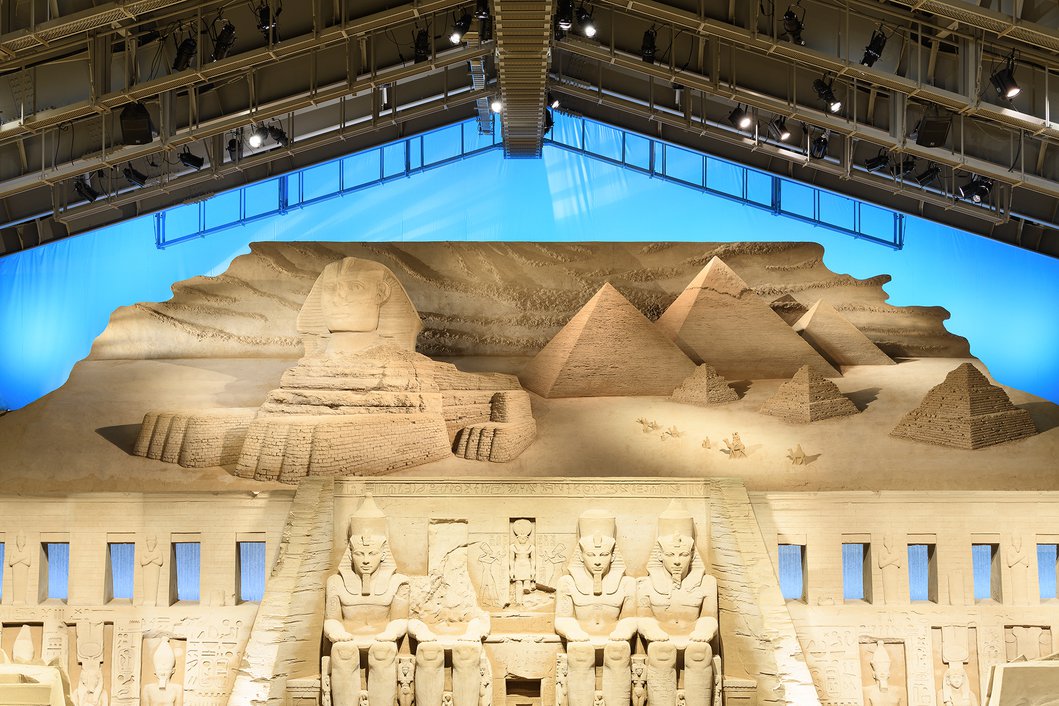
Pyramids and Sphinx of Giza
Built roughly 5,000 years ago during the Old Kingdom period, the Giza pyramid complex is a source of many mysteries for its purpose and building method. The Great Pyramid is the tomb of pharaoh Khufu. The oldest and the largest of the three pyramids, it is made up of over 2 million stone blocks with a height of around 138 m. It is considered an architectural marvel - each side of the base measures precisely around 230 m with only about a 20 cm difference, while the structure has remained almost horizontally level. The pyramid still retaining original outer casing stones at the top is the tomb of pharaoh Khafre, a son of Khufu. Though smaller than Khufu's pyramid, it was built on the higher ground giving the appearance that overshadows the rest. A son of Khafre, pharaoh Menkaure's pyramid is about half the size of the Great Pyramid. In addition, other associated pyramids are in the vicinity, including ones built for queens. Together, they have watched over Egypt for millennia from their tombs. The Great Sphinx, which sits in front of the pyramids, is a sacred creature from Egyptian mythology. Believed to have been built during Khafre's rule, it acts as the guardian of the tombs. With 73 m in length and 20 m in height, it is the world's largest statue made of a single rock slab. The Giza pyramid complex and the Sphinx, registered as a World Heritage site in 1979, continue to attract visitors with their spectacular scenery from the ancient past.
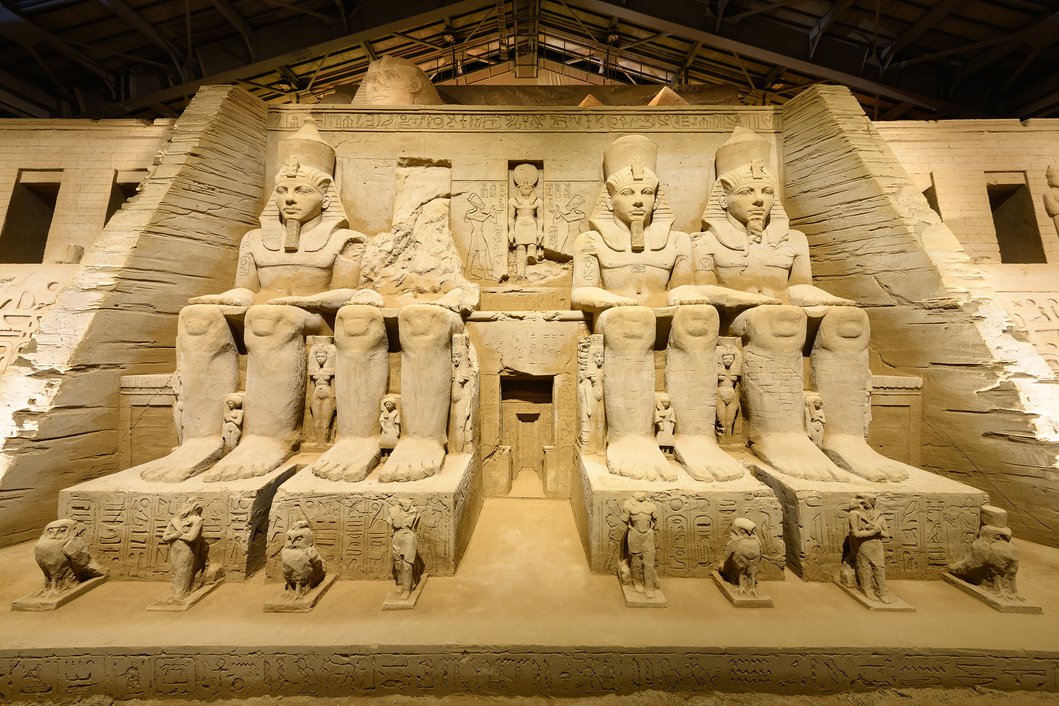
Pyramids and Sphinx of Giza
Built roughly 5,000 years ago during the Old Kingdom period, the Giza pyramid complex is a source of many mysteries for its purpose and building method. The Great Pyramid is the tomb of pharaoh Khufu. The oldest and the largest of the three pyramids, it is made up of over 2 million stone blocks with a height of around 138 m. It is considered an architectural marvel - each side of the base measures precisely around 230 m with only about a 20 cm difference, while the structure has remained almost horizontally level. The pyramid still retaining original outer casing stones at the top is the tomb of pharaoh Khafre, a son of Khufu. Though smaller than Khufu's pyramid, it was built on the higher ground giving the appearance that overshadows the rest. A son of Khafre, pharaoh Menkaure's pyramid is about half the size of the Great Pyramid. In addition, other associated pyramids are in the vicinity, including ones built for queens. Together, they have watched over Egypt for millennia from their tombs. The Great Sphinx, which sits in front of the pyramids, is a sacred creature from Egyptian mythology. Believed to have been built during Khafre's rule, it acts as the guardian of the tombs. With 73 m in length and 20 m in height, it is the world's largest statue made of a single rock slab. The Giza pyramid complex and the Sphinx, registered as a World Heritage site in 1979, continue to attract visitors with their spectacular scenery from the ancient past.

Great Temple at Abu Simbel
Located on the southern tip of Egypt, the Great Temple at Abu Simbel is the most famous temple built by Ramesses II. Situated on the western bank of the Nile, this rock-cut temple was built around 1250 BCE and is 33 m in height, 38 m in width, and 63 m in depth. Four massive sitting statues of Ramesses sit beside the entrance with smaller statues of his family at the feet. A statue of the sun god Ra Horakhty sits above the entranceway. One of Ramesses statue's upper body is damaged, but this most likely happened just a few years after the initial completion of an earthquake. Nevertheless, this magnificent temple showcased Ramesses' power far and wide. Thousands of years later, in the 1960s, the temple was back in the headlines. The planned construction of Aswan High Dam on the Nile upstream threatened the Abu Simbel temples with flooding. After UNESCO's call for preservation, help came from all over the world to relocate the temples to safer locations. This incident led UNESCO to establish the World Heritage Site registry, which Abu Simbel temples joined in 1979.
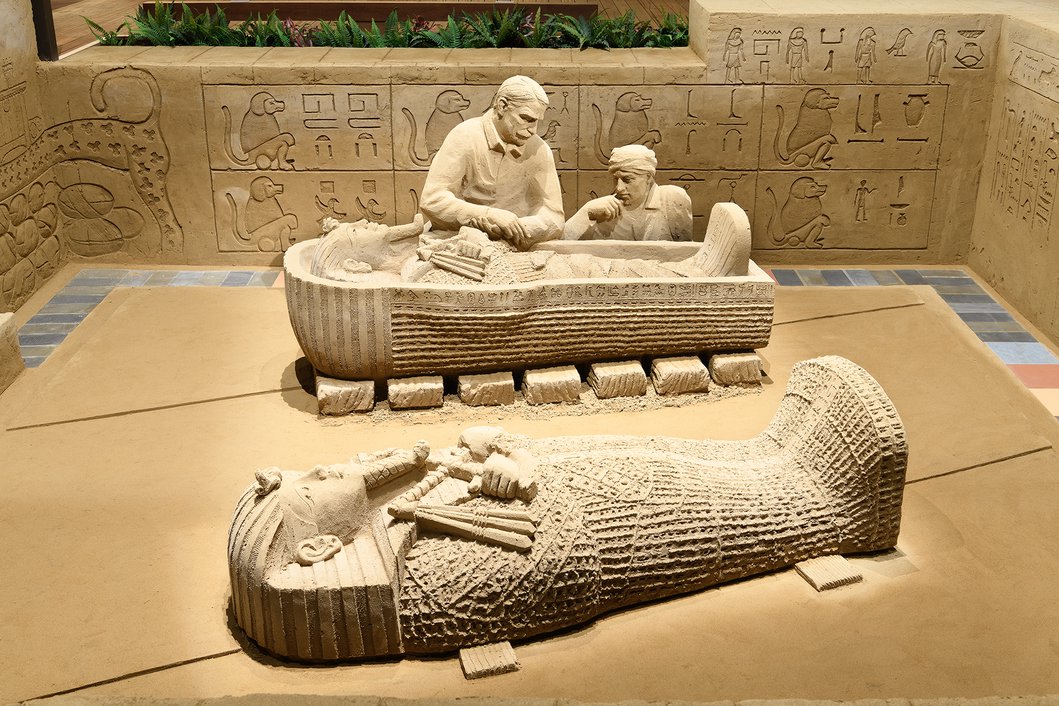
Discovery of Pharaoh Tutankhamun
The famous boy pharaoh Tutankhamun. Though he most likely ruled for around a decade from 1333 BCE, his name was lost to history. Everything changed with the discovery of his tomb by British archeologist Howard Carter in 1922. Labeled the "Discovery of the Century," it was the first royal burial to be found with the mummy and burial objects intact. Whereas thieves had plundered most other royal tombs over time, his survived because the entrance was by debris, and also his and his father Akhenaten's names were erased from history. The burial chamber was guarded by a Ka (spirit) statue of Tutankhamun. Over 5,000 burial items found were not limited to ornate accessories but also everyday items like furniture and clothes. Painting on the chamber walls depicted scenes of him being welcomed into the afterlife by gods and of holy baboons. In this piece, we see Carter opening the three-layered coffin to reach the mummy with the golden mask.
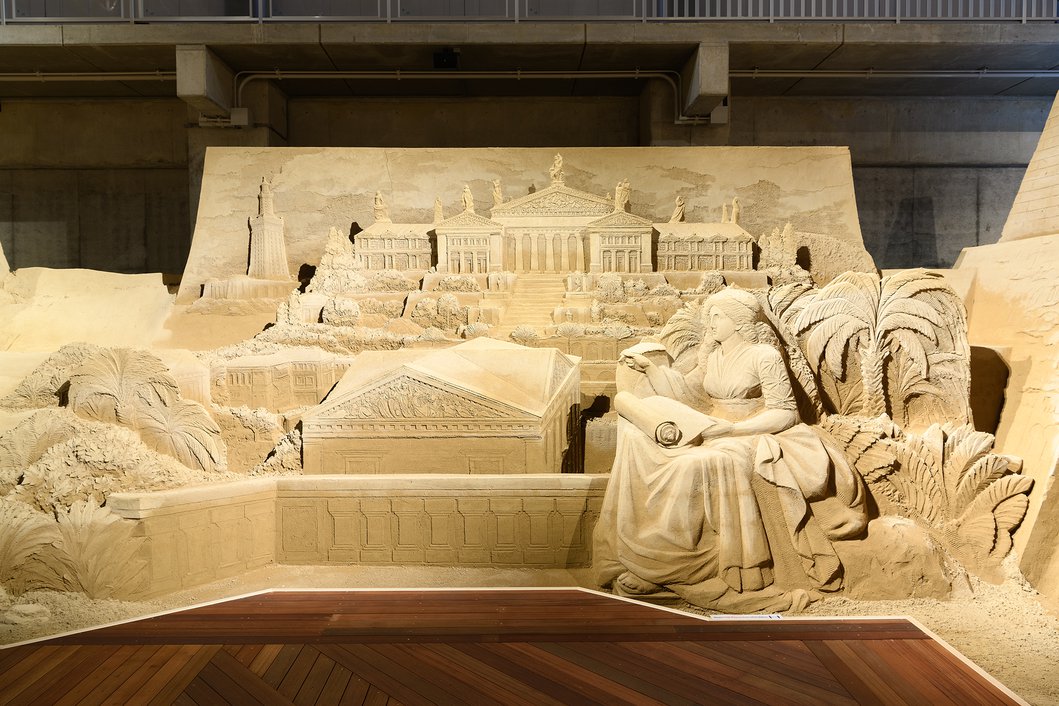
City of Alexandria
This Mediterranean city was founded in 332 BCE by Alexander the Great. During the Ptolemaic Dynasty period, it became the first ancient Egyptian capital located away from the Nile. It was known as an academic city. The pharaoh established a leading institution, called the Musaeum, that attracted bright scholars from around the world. One of its famous facilities, the Library of Alexandria, had a worldwide collection of books believed to have been the largest at the time. Unfortunately, the Musaeum, with its library, was destroyed as various conflicts engulfed the city over the years. At the same time, Alexandria was also a flourishing port city. In the port, a 146 m tall giant lighthouse was erected. This famous lighthouse watched over countless ships' journeys, but by the 14th century, it had experienced three earthquakes and was abandoned. How the ancient people built such a tall structure remains a mystery and is considered one of the Seven Wonders of the Ancient World.
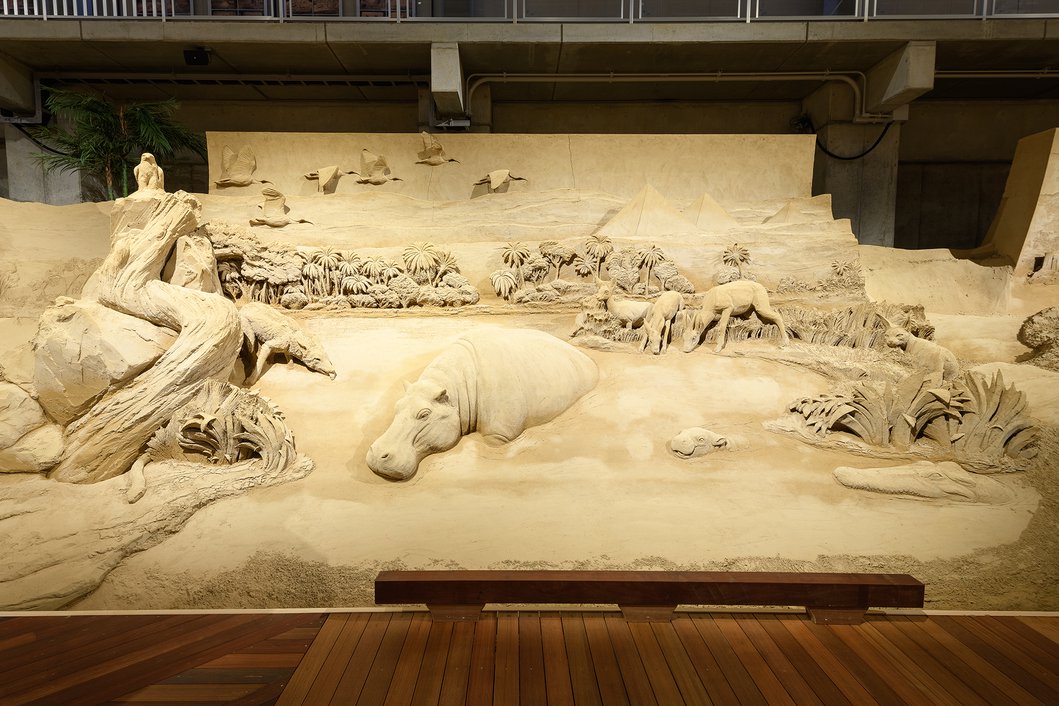
Sacred Animals
Egypt is home to a wide variety of animals. For ancient Egyptians, these animals symbolized nature's higher powers and were considered sacred. They also represented numerous gods - the falcon was considered the messenger of the sky god Horus; the ibis represented the god of wisdom Thoth; the jackal, which often dwelled near graves, became the god of death Anubis; the caracal and other cats, which hunted rats and snakes, were painted on walls of people's houses as guardian gods to protect over the family, Animals that lived near the Nile were also a very familiar presence - the gazelle was considered the messenger of the goddess of the Nile Anuket; the goddess of childbirth Taweret was typically depicted as a hippopotamus standing on two feet; the god of fertility Sobek was depicted as a crocodile, while at the same time, people prayed to Sobek for protection against crocodile attacks. Thus for ancient Egyptians, animals were objects of both reverence and fear.
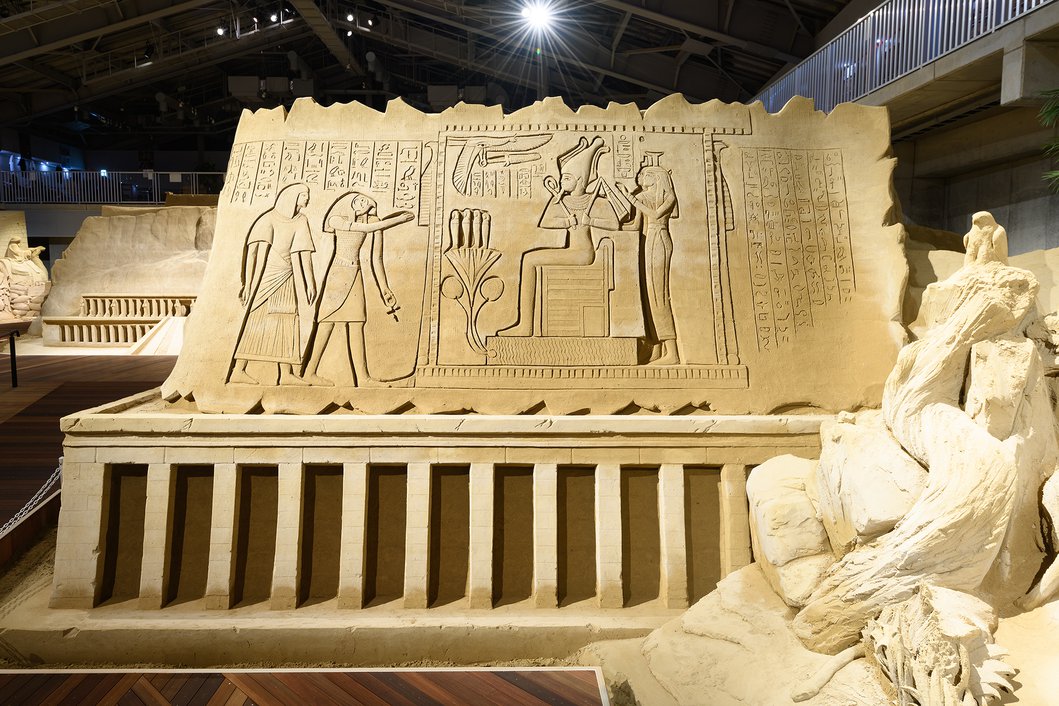
Ancient Egyptian Religion - Book of the Dead
Ancient Egyptians believed in the afterlife. During the New Kingdom period (after the 16th century BCE), scrolls called the "Book of the Dead" were placed in coffins to pray for a good voyage into the afterlife. These papyrus scrolls were written in ancient hieroglyph and contained spells and instructions to help the deceased overcome obstacles in reaching paradise. Out of around 190 chapters, "the Judgement of the Dead" is the most famous - god Anubis would weigh the deceased's heart on a pair of scales against ostrich feathers to judge whether they had committed any sins in their lifetime. If a scale tipped, a beast would devour the heart, and their soul lost forever. If the scales balanced themselves, god Horus would take them to meet god Osiris, the ruler of the afterlife. In his paradise, the deceased would be reborn into an eternal life of happiness.
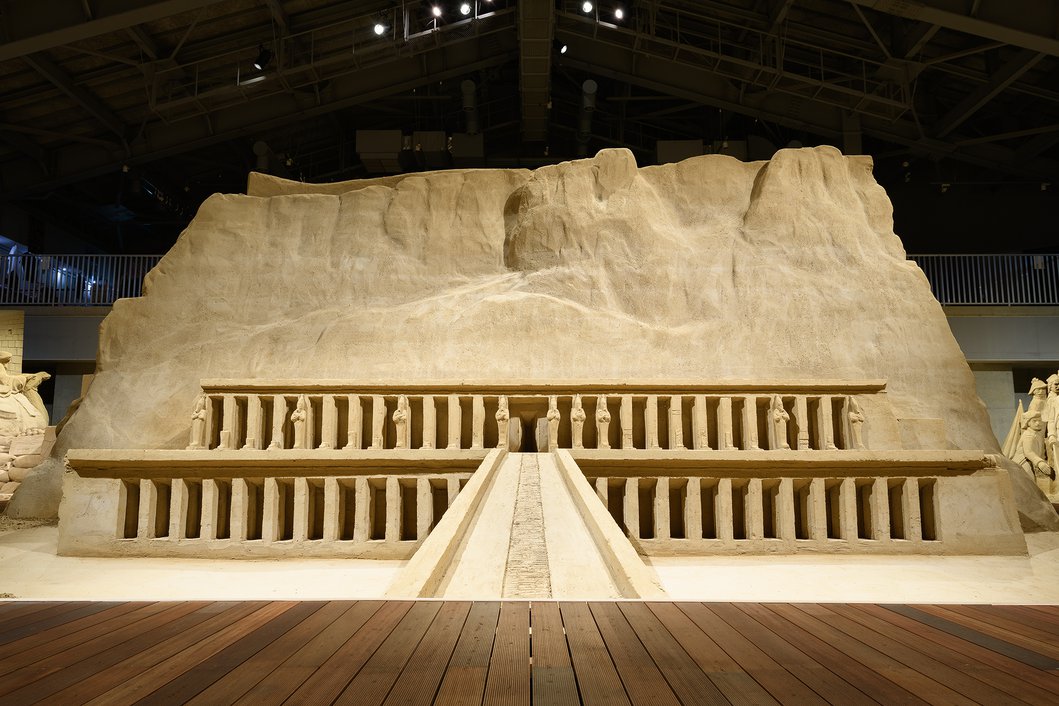
Mortuary Temple of Hatshepsut
The Mortuary Temple of Hatshepsut is renowned for its unique three massive terraces. In ancient Egypt, pharaohs built mortuary temples as places to conduct rituals for themselves after their death. Having ruled sometime during the 15th century BCE, Hatshepsut was noteworthy for being a rare female pharaoh. After the death of her husband, she initially ruled as a regent to the young Thutmose III, yet in a few years, she seized power for herself and began using the title of pharaoh. As skilled as she was in handling domestic affairs, she also fostered peaceful relationships with surrounding nations to promote active trade. From an architectural point of view, the Mortuary Temple of Hatshepsut, registered as a World Heritage Site in 1979, is considered one of ancient Egypt's greatest masterpieces. Built into a cliff, it has a symmetrical structure. The columns that line the top terrace are each fronted by a statue of Hatshepsut depicted as the god Osiris.
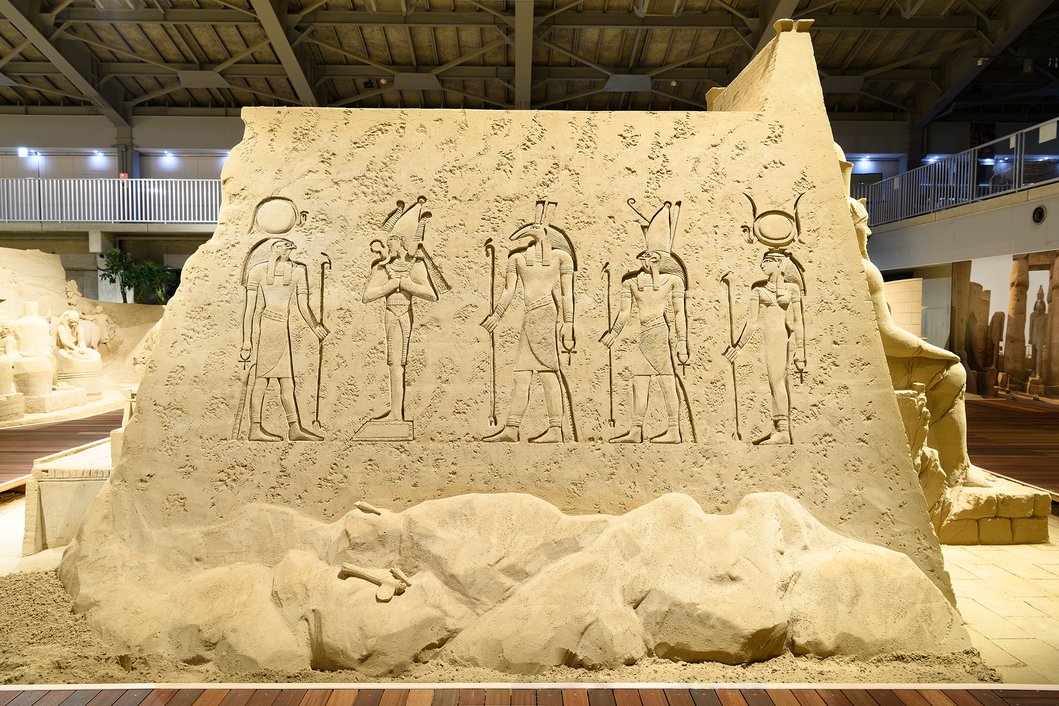
Gods of Ancient Egypt
Ancient Egyptians held polytheistic beliefs. They believed that gods dwelled everywhere in nature, such as the sun or a river, to animals, which possessed abilities beyond human capacity. Objects of worship differed depending on a region or time, but there likely were more than 1,000 gods. Depicted as a falcon with a sun disk above his head, the sun god Ra was the creator of all things, including gods and men. According to the myth, Osiris, the god of the dead and the ruler of the afterworld, gained eternal life after being resurrected. This tale had a profound influence on shaping the ancient Egyptian view of the afterlife. Typically depicted as an aardvark, the god of deserts Set is famous for the tales of his conflict with Horus. In the story, Set kills Osiris but is ultimately killed by vengeful Horus, a son of Osiris, the god of the sky who is depicted as a falcon. There were many goddesses as well. Horus' mother Hathor was typically depicted as a woman with cow horns and a sun disk. As a widely worshipped deity, she possessed many characteristics, such as a goddess of love and beauty, goddess of the dead, and the heavenly cow.
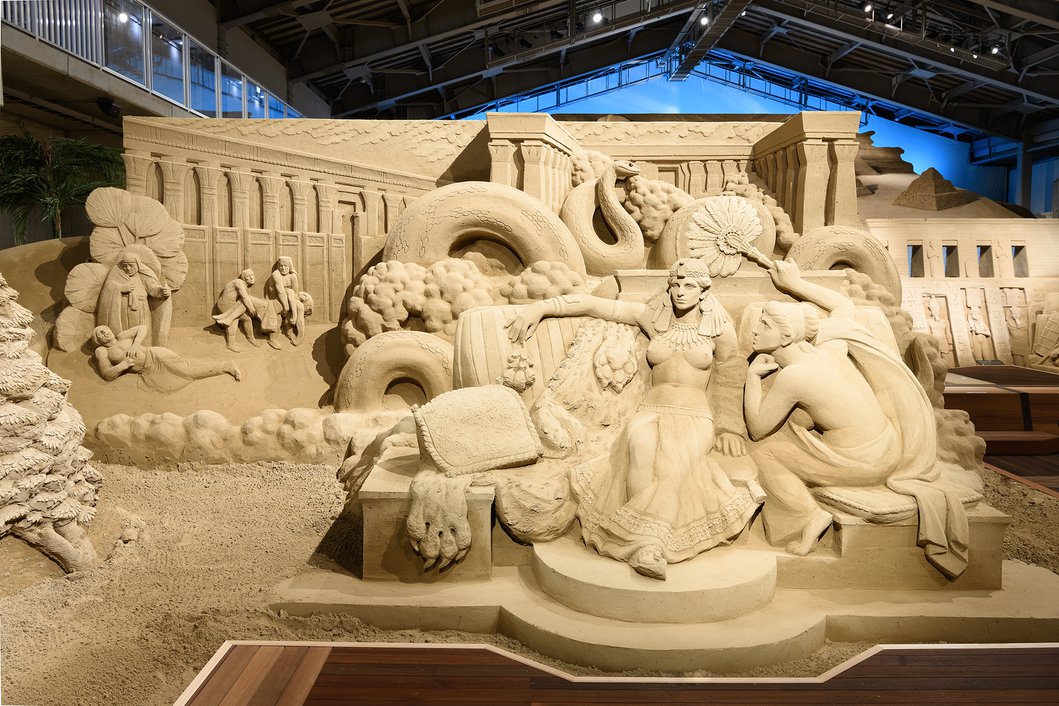
Cleopatra
Cleopatra was the last ruler of ancient Egypt. Although she is known for her beauty, she was also said to have been an intelligent woman who commanded seven languages. She initially co-ruled with her younger brother Ptolemy XIII. However, after a fallout that resulted in a civil war, she sought backing from the powerful Roman ruler Julius Caesar, with whom she later became a lover. A famous legend goes that she hid in a rolled carpet to meet Caesar privately. With Caesar on her side, Cleopatra was able to seize power in Egypt. However, their relationship was viewed unfavorably in Rome, and to make matters worse, Caesar was assassinated in 44 BCE. To protect her kingdom, she receives help from her new lover, a Roman general Mark Antony, and attempts to set up a new dynasty through their half-Roman children. However, the ongoing discord with Rome that resulted in heavy defeats in battles, plus the problem of water shortages at the Nile, put Cleopatra in a dire predicament. Tragically, Antony chooses to take his own life at the end, and Cleopatra follows suit. While she was kept a prisoner before her death, she would try various poisons to find a painless way to end her life. Her tragic life is the subject of numerous plays and films.
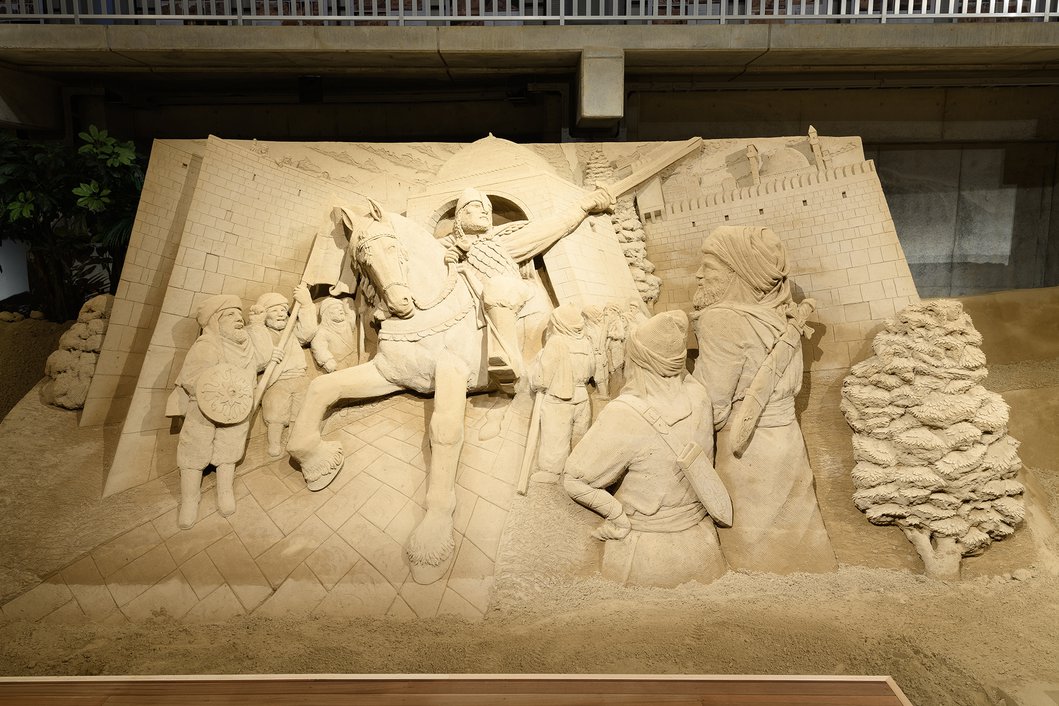
Spread of Islam
Islam, the dominant religion in present-day Egypt, was first brought into this region by the Muslim conquerors in the 7th century CE. They first set up their capital in Fustat, a part of modern-day Cairo, and built mosques in the surrounding areas. In 969, Cairo became the new capital. After the conquest, countless Arabic rulers ruled over Egypt, but perhaps the most legendary is Saladin, the first sultan of Egypt and the founder of the Ayyubid dynasty. In midst of the ongoing war between Islamic and the Crusader armies over the holy land of Jerusalem, which had begun in the 11th century, Saladin built defensive fortresses to protect Egypt from attacks on the Mediterranean front. After successfully capturing Jerusalem, he famously granted amnesty to all Christians. For his generosity, today he is considered a brave yet merciful hero,
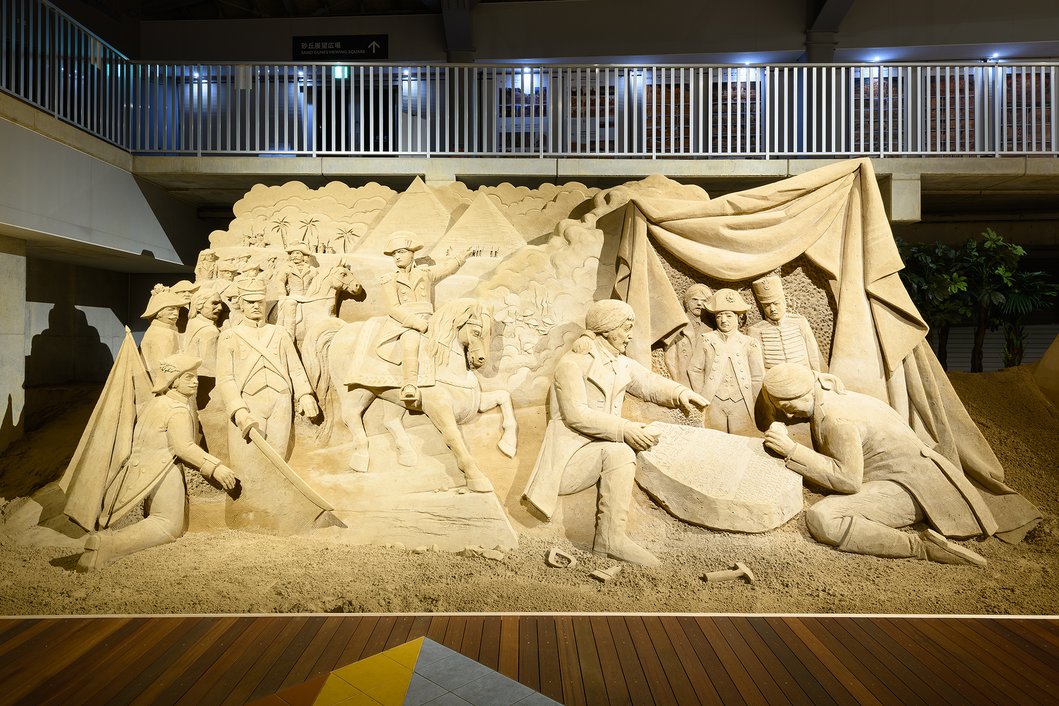
Napoleonic Campaign in Egypt and Discovery of the Rosetta Stone
The Rosetta Stone was the key to deciphering the ancient Egyptian hieroglyph. It was discovered in 1799 in the town of Rosetta by the French army during the Napoleonic campaign in Egypt. Though its main objective was to disrupt the British trade routes in the region, it also functioned as a scientific endeavor, for which more than 160 scientists and historians were brought along. One of their discoveries was the Rosetta Stone, which contained inscriptions in three languages: ancient Egyptian hieroglyphic, Demotic, and Ancient Greek. Upon discovery, scholars speculated that all three scripts had the same content, so they immediately began working on a decipherment. Finally, in 1822, a French scholar named Jean-François Champollion published the first decipherment of the hieroglyphs. By applying the theory that hieroglyphs not only represented meanings but sounds and his knowledge of the Greek language, he was able to shed a light on one of ancient Egypt's great mysteries. Ultimately, scripts written on papyrus and temple walls were deciphered, giving us insights into an ancient civilization that thrived for thousands of years.
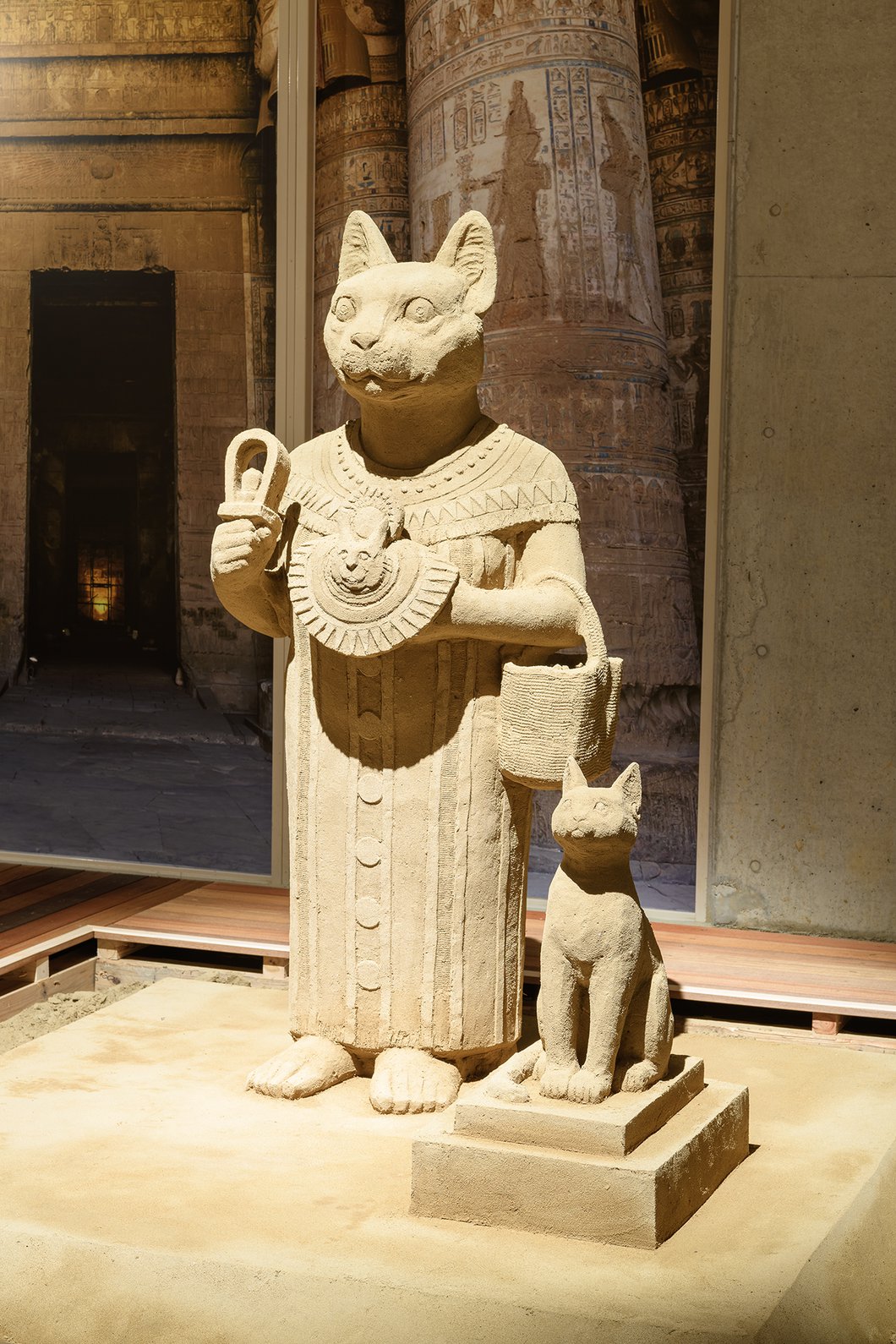
Bastet
Typically depicted as a cat, Bastet was a goddess of fertility and represented reproduction. Some believe that ancient Egyptians were the first to domesticate cats. Initially, they kept cats to hunt mice, but they eventually integrated into people's lives and became pets. They even became sanctified so that the goddess Bastet, traditionally depicted as a fierce lion, became commonly shown as a gentler cat. Sometimes she is also shown holding an instrument sistrum and standing on two feet. Although Egypt's religious beliefs have changed, cats remain a significant part of people's lives, and the goddess Bastet is popular worldwide for her adorable appearance.
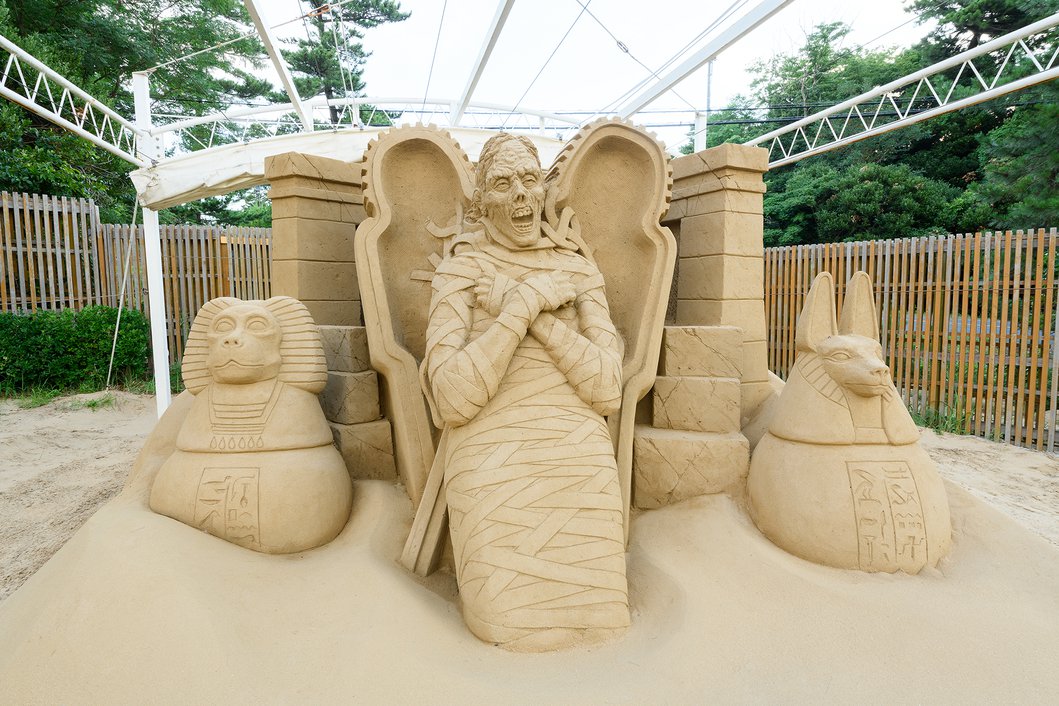
Mummies and Belief in the Afterlife
To make a mummy, a dead body is specially prepared to inhibit decomposition so that they retain the appearance of being alive. Ancient Egyptians believed that spirits of the dead left their bodies to face the last judgment but eventually returned for resurrection. Specially trained embalmers created many mummies for this reason. In mummy-making, organs were first taken out of a dead body, then after embalming, the body was wrapped in bandages. All the removed organs were stored in containers called canopic jars, each of which had a baboon or jackal head. Although this belief in rebirth was initially limited to the elites like the royal family, it gradually spread to the general public. Mummy-making was so prevalent that, besides humans, many dead animals were turned into mummies. Even though today's media portray mummies as terrifying monsters, for ancient Egyptians, mummification was the most desired burial method because they believed that the resurrected would continue to live a rich life as they had before.
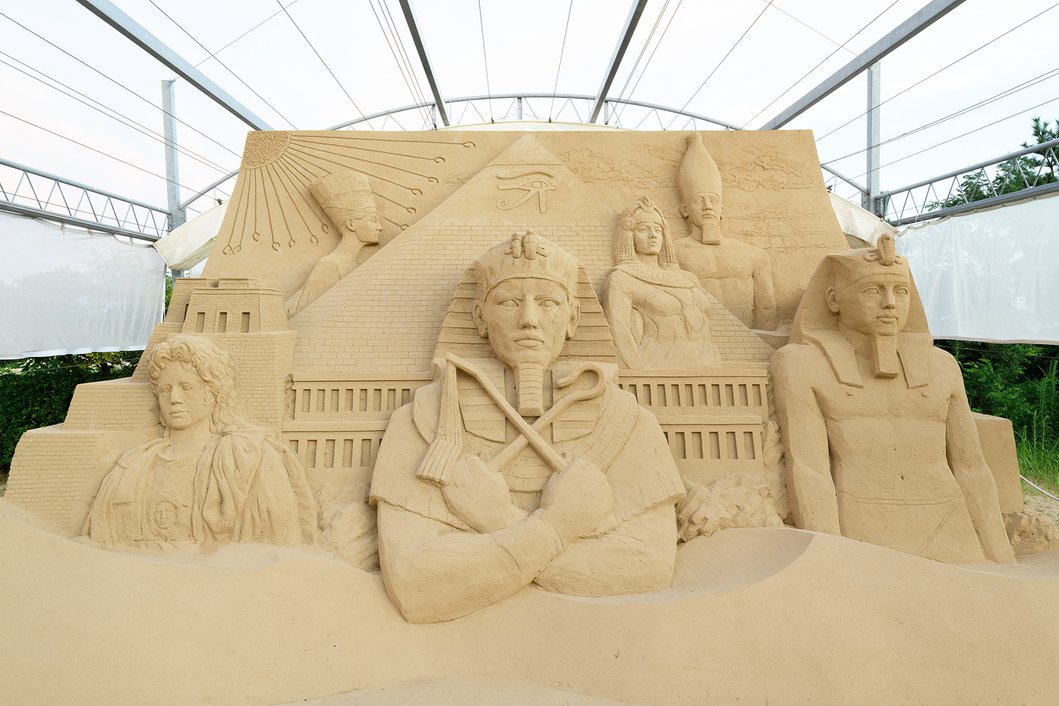
Tutankhamun
The year 2022 marks the 100th anniversary of the discovery of pharaoh Tutankhamun's tomb. Here, Tutankhamun is placed at the center and surrounded by Nefertiti, Ramesses Ⅱ, and Alexander the Great (clockwise from the top left). This piece was created in April 2022 as a part of the 14th Exhibition's promotional campaign. 2022. Japan/Katsuhiko Chaen
